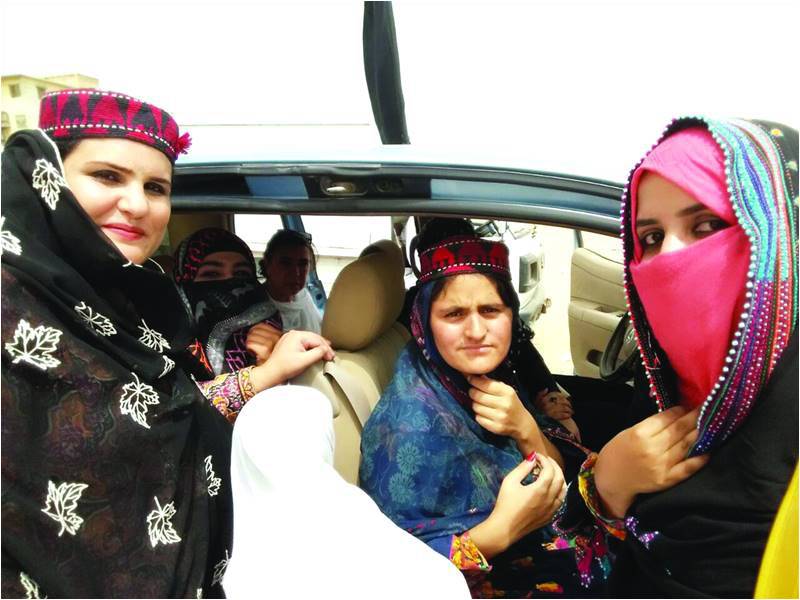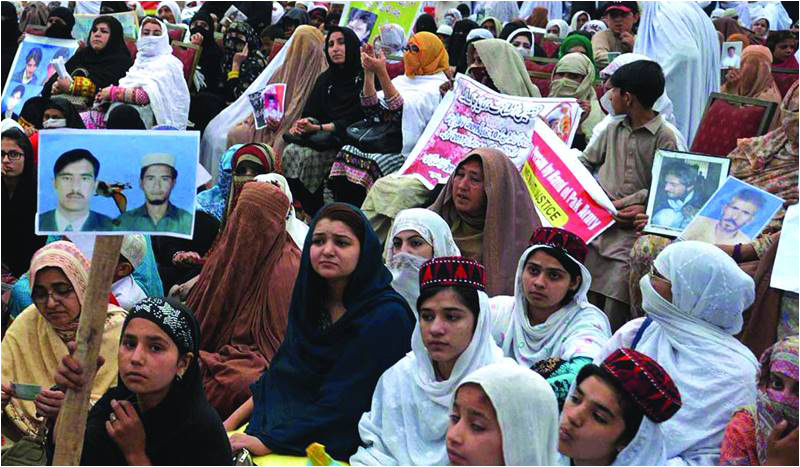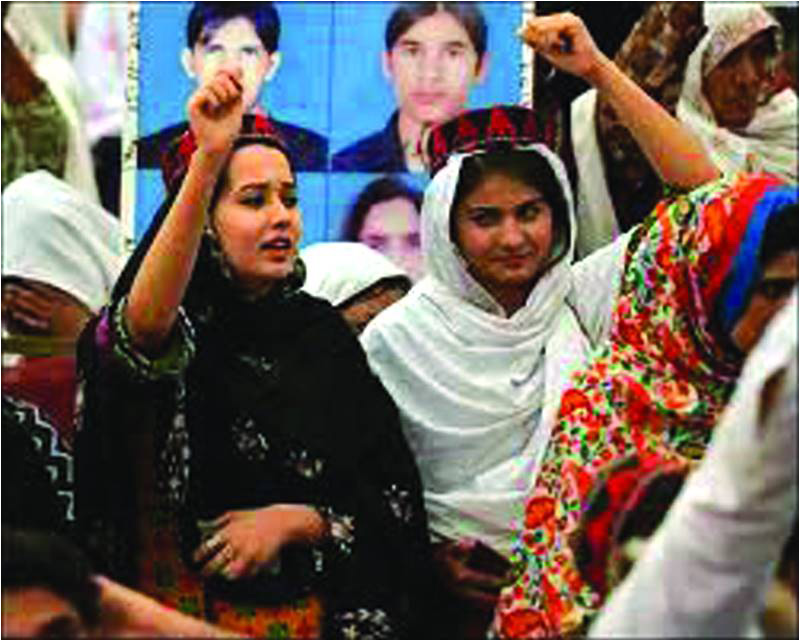
Fragmentary and atomized struggles get a people nowhere. We have to understand that the patriarchal society we have is maintained and imposed by the political forces that see us in having a particular position in the relations of production, which is a war economy. This is not to say that patriarchy is not ingrained in Pashtun culture (the culture overall being tribal) but that this kind of anti-women and patriarchal notions of masculinity, honour and violence sit well with the goals of political oppression. A national political struggle which excludes women and their particular oppression at hands of patriarchy will be toward a new kind of political and intimate violence. Not to say that such a struggle in itself will be incomplete, thus unsuccessful. There is no gender or socio-cultural struggle which also is not a political struggle. Fighting patriarchy ingrained in our society, our culture and our minds is the first and foremost political struggle as it radically changes our intimate spheres of life and thinking.
The relations of power, and thus oppression, are produced on social terrain where the political, cultural and economic are linked or integrated. Reducing the women’s struggle to the cultural or at best social domain (i.e. not affected by political and economic relations) is a harmful form of reductionism. Conceptualizing the national question as a political one without understanding how it the national oppression in itself operates to exclude women is a hollow analysis. Pashtuns face this particular national oppression because they are on lands which are essential for the war economy of a country to function. The national imaginary has to be defined vis-a-viz the ‘Other’. Pashtuns being the largest ethnic minority, having a share in power and thus influence, are a threat to that national imaginary. The de-ethnicized Pakistani has to be contrasted with an ethnic one. And Pashtuns become the perfect candidate because of their numbers and situationally in the relations of power. That is on the level of discourse which defines the contours of the national question. The material and practical manifestation of that ‘Otherization’ is through the necessity of a war economy.

That war economy needs the production of Pashtuns in a particular dehumanized way where they are readily available as expendables for the state’s policies of strategic depth as well collateral damage. What better way to sustain that war economy than reproducing the violent masculinity of Pashtuns and thus condemning women to the yoke of patriarchy? This, again, is not to say that patriarchy in Pashtun society is some kind of conspiracy by the state, but to say that the patriarchal notions of Pashtun masculinity (the tropes of brave, violent and chivalrous, thus martial race) feed into the political policies of the state and thus to the national oppression. Therefore, fighting against patriarchy is not only a gender and cultural question, but it also is a political one. Defining a new Pashtun masculinity, replacing patriarchy and incorporating women’s voices become a national question, too. If Pashtuns stop being “brave” and “ready to sacrifice for the nation” then they will become another kind of men. The kind who don’t have to be instruments and collateral damage for the state’s strategic policies. The result, of-course, will be challenging the logic of patriarchy in Pashtun society, which conceptualizes Pashtuns to be “violent”, “headstrong” and “brave” men. Challenging the Pashtun masculinity as defined by patriarchy is, thus, instrumental to solving the national question.
Women as social subjects/agents don’t enter into the national imaginary of Pakistan overall, and of Pashtuns and the ethno-national groups in particular. The only social subjectivity that is assigned/allowed to women by the state is that of a passive biological site for reproduction of the nation (the nation here including both the nation of the “nation-state” as well as the ethno-nation) to be regulated by the state (and patriarchal structures) as well as an object of national honor which has to be protected and patronized. Citizenship rights don’t automatically translate into the right and space to imagine the nation. The somewhat formal equality guaranteed in laws also is interrupted through a language which asserts the possession of women by the collective. This is not only the logic and pull of patriarchy but also the force of a post-colonial state coming to grips with a colonial modernity through inventing gendered history, national institutions and a national imaginary (based on a constructed revisionism) which is masculine, out in out, in celebration of a ‘history’ of war, violence and conquest.
This creates a perpetual anxiety in the state (as well as the ethno-nations) as to the agency and social subjectivity of women.

Feminism, after all, aims at a new kind of citizenship too, because citizenship without the right/claim to define a national imaginary is only a formal measure of the state. This duality in imaginary-citizenship for women creates a curious outsider-insider status for women, where they, being citizens, are in/part of the state while being women are outside of the national imaginary. But herein also lies the possibility of a constructive disruption. Any radical change always is brought from the outside. Women and feminism can rupture the national imaginary through their status as outsiders and can create a national imaginary which is inclusive and participatory.
It needs no emphasis that along women there are other categories of citizenship which are outsiders on the basis of religion, sect, class and ethnicity. So, the radical challenge to the current national imaginary will have to come from a solidarity of the “outsiders”. Thus, women’s rights and feminism shouldn’t be seen and treated as a struggle separate from that of other struggles of resistance. It, in fact, is an integral part of any struggle. Any struggle and resistance that is not clear and inclusive of the women’s “question” is an incomplete one. The current human rights and democratic resistance movements ongoing in the country will only strengthen themselves if they see integral nature of their struggle to that of feminism. By going beyond the patriarchal imagination, we will be inching toward totality of representation (of social relations) and hence to perfection and truth. And truth is proven in practice, as Marx would have it.
It has to be pointed out that all these struggles take place with the process of class and are integrally linked to that of the class struggle. Unfortunately, the politics of class struggle is on the margins and doesn’t occupy dominantly the public consciousness. The expansion of the national question, in this case the Pashtun national question, to contain in itself the women/gender question has to be articulated and integrated to the broader class struggle to fight the integral nature of oppression. The capitalistic-national exploitation is carried along the axis of nation, gender, caste and nation. The exploitation is integral in nature. So, too, must be the struggle against it.
Atomized struggles and fragmentation of resistance can go so far. To imagine an alternative future we have to see the totality of social relations of power and exploitation. Creating politics and networks of solidarity is the only way to conceive a radical break with oppression of today.
The relations of power, and thus oppression, are produced on social terrain where the political, cultural and economic are linked or integrated. Reducing the women’s struggle to the cultural or at best social domain (i.e. not affected by political and economic relations) is a harmful form of reductionism. Conceptualizing the national question as a political one without understanding how it the national oppression in itself operates to exclude women is a hollow analysis. Pashtuns face this particular national oppression because they are on lands which are essential for the war economy of a country to function. The national imaginary has to be defined vis-a-viz the ‘Other’. Pashtuns being the largest ethnic minority, having a share in power and thus influence, are a threat to that national imaginary. The de-ethnicized Pakistani has to be contrasted with an ethnic one. And Pashtuns become the perfect candidate because of their numbers and situationally in the relations of power. That is on the level of discourse which defines the contours of the national question. The material and practical manifestation of that ‘Otherization’ is through the necessity of a war economy.

That war economy needs the production of Pashtuns in a particular dehumanized way where they are readily available as expendables for the state’s policies of strategic depth as well collateral damage. What better way to sustain that war economy than reproducing the violent masculinity of Pashtuns and thus condemning women to the yoke of patriarchy? This, again, is not to say that patriarchy in Pashtun society is some kind of conspiracy by the state, but to say that the patriarchal notions of Pashtun masculinity (the tropes of brave, violent and chivalrous, thus martial race) feed into the political policies of the state and thus to the national oppression. Therefore, fighting against patriarchy is not only a gender and cultural question, but it also is a political one. Defining a new Pashtun masculinity, replacing patriarchy and incorporating women’s voices become a national question, too. If Pashtuns stop being “brave” and “ready to sacrifice for the nation” then they will become another kind of men. The kind who don’t have to be instruments and collateral damage for the state’s strategic policies. The result, of-course, will be challenging the logic of patriarchy in Pashtun society, which conceptualizes Pashtuns to be “violent”, “headstrong” and “brave” men. Challenging the Pashtun masculinity as defined by patriarchy is, thus, instrumental to solving the national question.
Women as social subjects/agents don’t enter into the national imaginary of Pakistan overall, and of Pashtuns and the ethno-national groups in particular. The only social subjectivity that is assigned/allowed to women by the state is that of a passive biological site for reproduction of the nation (the nation here including both the nation of the “nation-state” as well as the ethno-nation) to be regulated by the state (and patriarchal structures) as well as an object of national honor which has to be protected and patronized. Citizenship rights don’t automatically translate into the right and space to imagine the nation. The somewhat formal equality guaranteed in laws also is interrupted through a language which asserts the possession of women by the collective. This is not only the logic and pull of patriarchy but also the force of a post-colonial state coming to grips with a colonial modernity through inventing gendered history, national institutions and a national imaginary (based on a constructed revisionism) which is masculine, out in out, in celebration of a ‘history’ of war, violence and conquest.
This creates a perpetual anxiety in the state (as well as the ethno-nations) as to the agency and social subjectivity of women.

Feminism, after all, aims at a new kind of citizenship too, because citizenship without the right/claim to define a national imaginary is only a formal measure of the state. This duality in imaginary-citizenship for women creates a curious outsider-insider status for women, where they, being citizens, are in/part of the state while being women are outside of the national imaginary. But herein also lies the possibility of a constructive disruption. Any radical change always is brought from the outside. Women and feminism can rupture the national imaginary through their status as outsiders and can create a national imaginary which is inclusive and participatory.
It needs no emphasis that along women there are other categories of citizenship which are outsiders on the basis of religion, sect, class and ethnicity. So, the radical challenge to the current national imaginary will have to come from a solidarity of the “outsiders”. Thus, women’s rights and feminism shouldn’t be seen and treated as a struggle separate from that of other struggles of resistance. It, in fact, is an integral part of any struggle. Any struggle and resistance that is not clear and inclusive of the women’s “question” is an incomplete one. The current human rights and democratic resistance movements ongoing in the country will only strengthen themselves if they see integral nature of their struggle to that of feminism. By going beyond the patriarchal imagination, we will be inching toward totality of representation (of social relations) and hence to perfection and truth. And truth is proven in practice, as Marx would have it.
It has to be pointed out that all these struggles take place with the process of class and are integrally linked to that of the class struggle. Unfortunately, the politics of class struggle is on the margins and doesn’t occupy dominantly the public consciousness. The expansion of the national question, in this case the Pashtun national question, to contain in itself the women/gender question has to be articulated and integrated to the broader class struggle to fight the integral nature of oppression. The capitalistic-national exploitation is carried along the axis of nation, gender, caste and nation. The exploitation is integral in nature. So, too, must be the struggle against it.
Atomized struggles and fragmentation of resistance can go so far. To imagine an alternative future we have to see the totality of social relations of power and exploitation. Creating politics and networks of solidarity is the only way to conceive a radical break with oppression of today.

